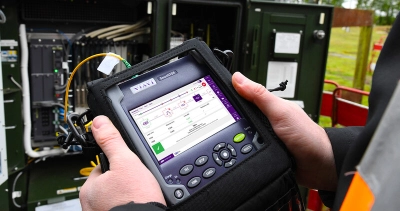Innovative robotic vision solutions enhance automation and precision.
Innovative robotic vision solutions enhance automation and precision.
Blog Article
Revealing the Key Utilizes of Optical Fiber Examining for Efficient Information Transmission
In the realm of modern-day communication, optical fiber screening emerges as a necessary method for optimizing information transmission. Recognizing the multifaceted applications of optical fibre testing welcomes a much deeper exploration into its crucial role in forming the future of data interaction.

Significance of Optical Fibre Testing
The importance of optical fibre screening can not be overemphasized, as it functions as an important part in making sure the dependability and effectiveness of information transmission systems. In an age where high-speed interaction is critical, any type of shortages in fiber optics can result in considerable information loss and reduced efficiency. Consequently, rigorous testing methods are necessary to confirm the honesty and performance of optical wires.
Checking enables the identification of issues such as micro-bends, macrobends, and splice losses that could impede signal high quality. Additionally, it provides insights right into the overall depletion and data transfer abilities of the fiber, ensuring that the network fulfills particular functional criteria. Routine testing not just boosts system efficiency yet also lengthens the life expectancy of the infrastructure by identifying possible problems prior to they intensify into expensive failures.

Kinds of Optical Fiber Examinations
Numerous kinds of optical fibre examinations are conducted to ensure the efficiency and integrity of fiber optic networks. These examinations can be classified right into numerous crucial types, each offering a particular purpose in assessing the stability of the fibre.
First, Optical Time Domain Name Reflectometry (OTDR) is a prominent test that determines mistakes, mates, and adapters within the fibre. By sending pulses of light and evaluating the mirrored signals, specialists can determine concerns along the fibre's size.
2nd, insertion loss tests review the quantity of signal loss when light go through adapters or splices, which is crucial for preserving network efficiency.
Third, return loss examinations determine the amount of light mirrored back towards the resource, providing understandings right into the top quality of links and possible resources of disturbance.
In addition, connection examinations make sure that the fiber path is total, allowing professionals to confirm that the fiber is intact with no breaks. optical fibre diameter analyser.
Finally, aesthetic mistake locators make use of noticeable light to determine breaks or extreme bends in the fibre, helping in quick troubleshooting. Collectively, these examinations develop a detailed strategy to preserving optimal performance in fiber optic networks.

Applications in Network Upkeep
In modern telecommunications, effective network maintenance counts greatly on optical fiber testing to determine and rectify concerns without delay. Routine screening ensures that the network operates at optimal efficiency degrees, decreasing downtime and improving customer experience.
One of the main applications of optical fibre screening in maintenance is the discovery of faults, such as breaks, bends, or incorrect connections. Strategies like Optical Time Domain Reflectometry (OTDR) allow service technicians to find these issues accurately and evaluate the top quality of the fibre link. Additionally, loss screening verifies the stability of the optical course, making sure that signal attenuation continues to be within acceptable limitations.
Regular upkeep screening additionally helps in preventive steps, determining potential problems prior to they rise into significant failings. This positive approach can conserve companies both time and monetary resources. Throughout upgrades or developments, optical fiber screening guarantees that brand-new installments incorporate seamlessly with existing facilities.
Enhancing Data Transmission Dependability
Reliable network maintenance through optical fiber screening not only addresses prompt concerns however additionally plays a considerable role in improving data transmission dependability. By recognizing faults, determining signal loss, and analyzing the total condition of fibre optic cable televisions, screening guarantees that potential problems are corrected before they escalate into significant disruptions.
Normal optical fibre testing, such as time-domain reflectometry (TDR) and optical time-domain reflectometry (OTDR), enables technicians to pinpoint the exact locations of breaks, bends, or adapter problems within the network. This aggressive approach not only decreases downtime but likewise maximizes the efficiency of data transmission by ensuring that the pathways for signals are clear and operating effectively.
In addition, navigate to this website screening help in verifying adherence to industry requirements and requirements, which is vital for maintaining the integrity of data flow. By guaranteeing that each connection meets required thresholds for loss and high quality, organizations can strengthen their confidence in the dependability of their data networks.
Inevitably, spending in extensive optical fiber screening not only improves data transmission reliability but additionally sustains the long-lasting operational effectiveness of communication Check This Out facilities.
Future Fads in Fiber Screening
Arising innovations are positioned to transform fibre testing, leading the means for enhanced effectiveness and accuracy in data transmission diagnostics (fibre testing equipment). As the demand for faster web and higher transmission capacity proceeds to increase, the combination of sophisticated devices such as man-made knowledge (AI) and artificial intelligence (ML) is readied to transform typical fibre screening approaches. These innovations will allow predictive maintenance and automated mistake detection, dramatically minimizing downtime and enhancing network integrity
Furthermore, the adoption of Internet of Things (IoT) tools will facilitate real-time tracking of fiber networks, permitting prompt recognition of performance problems. This shift in the direction of positive administration will certainly lessen disruptions and weblink enhance information circulation.
Moreover, innovations in optical time-domain reflectometry (OTDR) and new screening requirements will boost the precision of measurements, guaranteeing that data honesty is maintained throughout the transmission procedure. The arrival of 5G technology also demands the development of extra sophisticated fibre testing techniques to sustain its high-speed demands.
Conclusion
In final thought, optical fiber screening is crucial for maintaining reliable information transmission within communication networks. Regular screening not just guarantees compliance with sector requirements but likewise promotes positive maintenance, eventually adding to the long-term dependability and efficiency of fiber optic systems.
Report this page